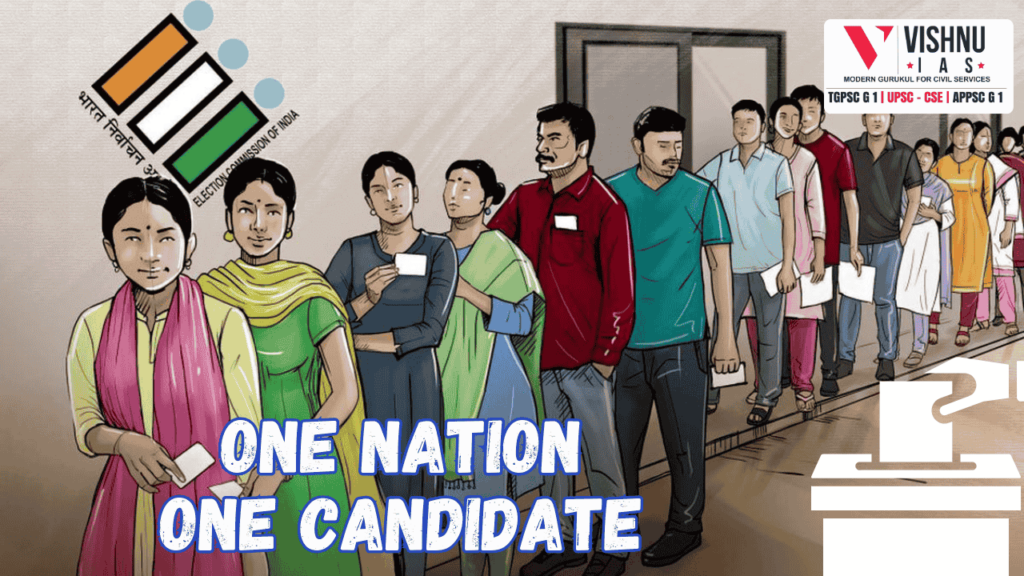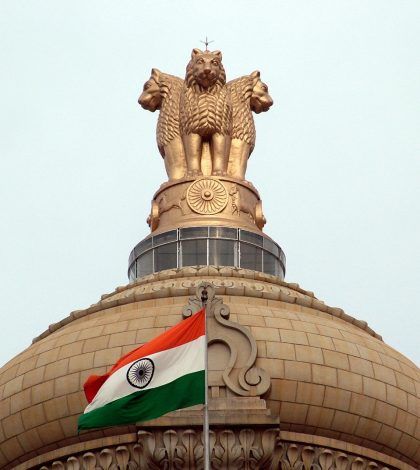One Nation One Candidate
A Vision for Unified Political Representation
In today’s fast-paced and politically dynamic world, the concept of “One Nation One Candidate“ has emerged as a potential solution to streamline elections, reduce costs, and promote unity in governance. This idea envisions a single candidate representing the collective aspirations of the people in a constituency or even the nation as a whole. While still a theoretical concept in many democracies, its relevance has sparked debates among policymakers, political analysts, and voters alike.
For countries like India, where diversity and democracy are deeply intertwined, the “One Nation, One Candidate” model offers both opportunities and challenges. This blog will provide a comprehensive understanding of the concept, its potential benefits, drawbacks, and how it could reshape the electoral and governance systems. Additionally, it will address the practical implications of this idea and its relevance for voters, political parties, and the nation as a whole.
What is One Nation One Candidate?
The concept of “One Nation, One Candidate” revolves around the idea of having a single candidate contest elections in a constituency or across the nation. Instead of multiple candidates from different political parties competing for votes, a consensus-based candidate is chosen to represent the collective interests of the people.
This candidate could be selected through:
Pre-election agreements among political parties.
Consensus-building mechanisms facilitated by independent bodies.
Public consultations or democratic primaries to ensure transparency and fairness.
The underlying aim is to promote collaboration, reduce electoral competition, and ensure that the elected representative enjoys broader support and legitimacy.
Why is the Concept of One Nation One Candidate Important?
1. Reducing Electoral Costs
One of the primary reasons for exploring the “One Nation, One Candidate” model is the rising cost of elections. Conducting elections in a large democracy like India requires significant financial resources, both for the government and political parties. According to reports, the 2019 Lok Sabha elections cost over ₹60,000 crores, making it one of the most expensive elections in the world.
By having a single candidate, the following costs can be significantly reduced:
Campaign expenses (rallies, advertisements, and promotions).
Government expenditure on election logistics.
Resources spent on security and management during elections.
2. Reducing Political Polarization
Multi-party elections often lead to intense political rivalry, which can result in divisive campaigns, polarization, and social unrest. Parties sometimes focus more on attacking opponents rather than presenting their vision for governance. A single candidate approach promotes cooperation and consensus, reducing unnecessary political conflicts and fostering harmony.
3. Greater Representation and Legitimacy
In a fragmented electoral system, candidates often win with a small percentage of votes due to vote splitting among multiple contenders. For example, in many constituencies, a candidate may win with only 30-40% of the votes, leaving a significant portion of the electorate unrepresented.
The “One Nation, One Candidate” system ensures that the chosen candidate has broader support and legitimacy, representing the collective will of the majority.
4. Promoting National Unity
In diverse nations like India, elections often highlight regional, religious, and caste-based differences. While diversity is a strength, it can sometimes lead to identity-based politics. A consensus-based candidate system shifts the focus towards collective aspirations, national priorities, and shared goals, fostering a sense of unity.
5. Stable and Efficient Governance
Political fragmentation can lead to unstable governments, especially in coalition setups. By promoting consensus and reducing competition, the “One Nation, One Candidate” model ensures stable governance, allowing policymakers to focus on development rather than political survival.
How Can One Nation One Candidate Work?
The implementation of the “One Nation, One Candidate” model requires careful planning and institutional mechanisms to ensure fairness, transparency, and inclusivity. Below are some possible approaches:
1. Pre-Election Alliances
Political parties can form alliances and agree to field a single candidate in each constituency. This requires parties to prioritize national interests over partisan agendas and work together to identify a consensus candidate.
2. Democratic Primaries
A democratic process, such as primaries, can be conducted within alliances to select the most suitable candidate. This ensures that the chosen candidate has the support of both the parties and the people.
3. Independent Electoral Panels
An independent electoral commission or panel can oversee the selection of candidates. This body can facilitate consultations among stakeholders, ensuring that the process remains impartial and transparent.
4. Public Consultations and Opinion Polls
To ensure inclusivity, public consultations, opinion polls, or referendums can be conducted to gather feedback from voters on potential candidates. This allows citizens to actively participate in the selection process.
5. Legal and Policy Framework
For the “One Nation, One Candidate” model to work effectively, legal reforms and policies need to be introduced. These reforms must address concerns related to transparency, democratic choice, and political competition.
Benefits of One Nation One Candidate
1. Cost-Effective Elections
By reducing the number of candidates contesting elections, the financial burden on the government, political parties, and taxpayers can be minimized. The saved resources can be redirected toward public welfare and development programs.
2. Unity in Politics
The model promotes collaboration and consensus among political parties, reducing unnecessary conflicts and polarization. This fosters a healthier political environment and strengthens democracy.
3. Broader Representation
A single candidate system ensures that the chosen representative has wider support, addressing the issue of vote splitting and underrepresentation
4. Stability and Governance
Stable governments are essential for long-term development and policy implementation. The “One Nation, One Candidate” approach reduces political instability, allowing leaders to focus on governance rather than electioneering.
5. Focus on National Priorities
By promoting consensus and unity, the model shifts the focus from identity-based politics to national priorities such as economic growth, education, healthcare, and infrastructure.
Challenges of One Nation One Candidate
While the concept offers several benefits, it also raises significant challenges:
1. Democratic Choice
One of the fundamental principles of democracy is the freedom to choose among multiple candidates. Restricting elections to a single candidate may undermine this principle and limit voters’ options.
2. Political Monopoly
The model could lead to political monopolies, where dominant parties or coalitions control the electoral process. This may marginalize smaller parties and independent candidates, reducing political diversity.
3. Difficulty in Consensus Building
Achieving consensus among political parties is challenging, especially in a diverse and multi-party democracy like India. Conflicting ideologies, regional interests, and political ambitions can hinder the process
4. Risk of Voter Disengagement
With limited options, voters may feel disengaged or disillusioned with the electoral process. A lack of competition can reduce voter enthusiasm and participation.
5. Implementation Challenges
Implementing the “One Nation, One Candidate” model requires significant legal, political, and institutional reforms. Ensuring fairness, transparency, and inclusivity in the selection process is a complex task.
Global Examples of Consensus Candidates
The idea of consensus candidates is not entirely new. Several countries have experimented with similar models in specific contexts:
1. National Unity Governments
During times of crisis, countries like the United Kingdom and South Africa have formed national unity governments, where political parties set aside their differences to work together.
2. Presidential Elections
In some countries, presidential candidates are chosen through pre-election alliances or consensus among major parties to ensure broader support and legitimacy.
3. Local Elections
At the local level, consensus candidates are sometimes chosen to avoid divisive elections and promote community harmony.
Is One Nation One Candidate Feasible in India?
India’s vast diversity and multi-party democracy present both opportunities and challenges for implementing the “One Nation, One Candidate“ model.
Opportunities:
Reducing electoral costs.
Promoting national unity and stability.
Addressing vote fragmentation and underrepresentation.
Challenges:
Ensuring democratic choice and political diversity.
Overcoming ideological and regional differences.
Implementing legal and institutional reforms.
While the model may not be fully feasible, certain elements such as pre-election alliances, consensus-building mechanisms, and cost-effective electoral practices can be explored to strengthen the democratic process.
Anthropology Full Course at Vishnu IAS Academy
What does Course Offer?
- 4 Months (250+ Class Hours)
- Online (App + Web) / Offline / Hybrid Mode of Classes
- Live + Recorded Videos Access For 1 Year
- 2 Hour Live Class From Monday to Saturday (1.5 Hours for Class + ½ Hour for Doubt Solving)
- Foundation to Advanced Level of Teaching
- Simple and Integrated Content
- One Stop Solution Books
- Regular Value Added Content
- Current Affairs & Case Studies Modules
- Daily Answer Writing Practice
- Weekly Grand Tests On Sundays & Evaluation With Guidance and Topper Will be Rewarded
- 500+ Model Answers
- 9 AM – 9 PM Support System
- Free GS Current Affairs
- Free Interview Guidance for Anthropology


